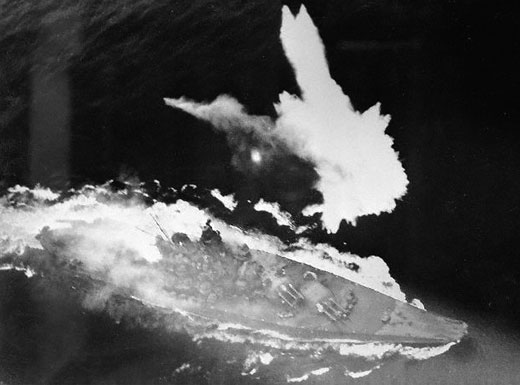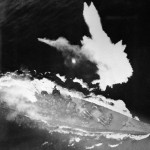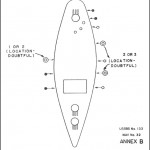There are many stories about the sinking of the Japanese battleship Yamato. Below are some of those stories and some links to other web sites with more stories about the ship and it’s final day, April 7, 1945.
(Follow paragraphs from Wikipedia as of 10/14/2009)
Yamato (大和), named after the ancient Japanese Yamato Province, was a battleship of the Imperial Japanese Navy during World War II. Flagship of the Japanese Combined Fleet, she was lead ship of the Yamato class. She and her sister ship, Musashi, were the largest and heaviest battleships ever constructed, displacing 72,800 tonnes at full load, and armed with nine 46 cm (18.1 inch) main guns.
Constructed from 1937 – 1940 and formally commissioned in late 1941, Yamato served as the flagship of Admiral Isoroku Yamamoto throughout 1942, first sailing as part of the Combined Fleet during the Battle of Midway in June 1942. Throughout 1943, Yamato continually transferred between Truk, Kure and Brunei in response to American airstrikes on Japanese island bases. The only time Yamato fired her main guns at enemy targets was in October 1944, but was ordered to turn back after attacks by destroyers and aircraft of the “Taffy” light escort carrier task groups managed to sink three heavy cruisers during the Battle off Samar.
(portions removed)
On 1 January 1945, Yamato, Haruna and Nagato were all transferred to the newly reactivated 1st Battleship Division; Yamato left drydock two days later.[1] When the 1st Battleship Division was deactivated once again on 10 February, Yamato was reassigned to the 1st Carrier Division. On 19 March 1945 Yamato came under heavy attack when American carrier aircraft from Enterprise, Yorktown and Intrepid raided the major naval base of Kure where she was docked.[25][26] Damage to the battleship, however, was light,[25] due in part to the base being defended by elite veteran Japanese fighter instructors flying Kawanishi N1K “Shiden” or “George” fighters.[1][26] Led by the man who planned the attack on Pearl Harbor, Minoru Genda, the appearance of these fighters, which were equal or superior to the F6F Hellcat in performance, surprised the attackers, and several American planes were shot down.[26] Heavy antiaircraft defensive fire and the heavy upper-deck armour plating on Yamato also prevented any significant damage to the vessel. On 29 March, Yamato took on a full stock of ammunition, in preparation for combat off Okinawa in Operation Ten-Go.[1]
Operation Ten-Go was a deliberate suicide attack against American forces off Okinawa by Yamato and nine escorts, beginning on 6 April 1945. Embarking from Kure, Yamato was to beach herself near Okinawa, and act as an unsinkable gun-emplacement—bombarding American forces on Okinawa with her 18.1-inch heavy-guns. Yamato carried only enough fuel to reach Okinawa, as the fuel stocks available were insufficient to provide enough fuel to reach Okinawa and return.[27] While navigating the Bungo Strait, Yamato and her escorts were spotted by the American submarines Threadfin and Hackleback, both of which notified Task Force 58 of Yamato‘s position.[1][5]
At 12:32 on 7 April 1945, Yamato was attacked by a first wave of 280 aircraft from Task Force 58, taking three hits (two bombs, one torpedo).[1] By 14:00, two of Yamato‘s escorts had been sunk.[5] Shortly afterward, a second strike of 100 aircraft attacked Yamato and her remaining escorts. At 14:23, having taken 10 torpedo and 7 bomb hits, Yamato‘s forward ammunition magazines detonated.[5] The smoke from the explosion—over 4 miles (6.4 km) high—was seen 100 miles (160 km) away on Kyūshū.[28] An estimated 2,498 of the 2,700 crew members on Yamato were lost, including Vice-Admiral Seiichi Itō, the fleet commander.[1]
-
Yamato Museum
-
Battleship Yamato with 35 photographs (WW2DB)
-
Yamato record of movement
-
What did the US Navy know about Yamato and when?
- Japanese Battleship Yamato – minutes before sinking
- Illustration of bomb and torpedo hits on battleship Yamato, 7 Apr 1945.
(Following from PBS Television “Sinking of the Supership“)
The final phase of the Pacific war during World War II saw a terrible new tactic: massed kamikaze attacks on American ships by Japanese planes. But the biggest kamikaze attack of all was the suicidal mission of the super battleship Yamato, the largest, most advanced warship of the day. In this program, NOVA joins an international team exploring the grave of this magnificent vessel to learn the secrets of her design, her final mission, and the violent events that brought her down.
Yamato lies on the floor of the East China Sea, 200 miles north of Okinawa, blown apart by one of the most massive explosions ever to occur at sea. Altogether, more than 2,700 men went down with the ship or drowned after it sank, making the loss of the Yamato one of the greatest naval disasters of all time. Despite the destruction, the majesty of the ship is unmistakable, symbolized by a six-foot-wide chrysanthemum crest, icon of the Japanese imperial family, still gracing Yamato‘s prow like a figurehead.
NOVA interviews two survivors of the sinking, who had to meet the most stringent requirements in the Japanese navy to be chosen for the crew. Also interviewed is an American dive-bomber pilot who took part in the attack.
Aircrews were astonished at the size of the ship, which had seen very little naval action during the war. Built in total secrecy and launched just after the attack on Pearl Harbor, Yamato may have been almost twice the size of her American counterparts, with the largest guns ever mounted on a warship.
Most of her engineering drawings have disappeared and few photographs survive, making Yamato‘s exact dimensions and design a mystery. One of her junior designers tells NOVA he was completely in the dark about the scale of the vessel that he was helping to create: “I was building the biggest ship in the world, and I didn’t even know it until after the war.”
Japan’s secrecy was due to her inability to match U.S. naval power ship for ship. Instead, military leaders decided to build a secret weapon that could engage many enemy ships at once. Her main guns were designed to attack at an unprecedented distance of 25 miles, well beyond the range of American battleships.
Had Yamato ever encountered an Allied battleship group, she could have floated safely out of range, while destroying each ship in turn. Instead, Yamato was obsolete the day she was launched, as the Japanese themselves proved at Pearl Harbor and elsewhere by sinking Allied battleships with airpower. World War II would see the aircraft carrier emerge as the key to naval supremacy, supplanting the battleship.
Forced to wait out much of the war due to her vulnerability to air attack, Yamato was committed in a last, desperate gamble during the Battle of Okinawa in April 1945. As waves of kamikazes took to the sky to defend the island, Yamato was ordered to sea on a mission to emulate the suicide planes and take out as many American ships as possible.
Of the just over 3,000 men aboard the Yamato on the morning of April 7, 1945, fewer than 300 were alive at day’s end. In the interviews below, meet two Yamato veterans still haunted by memories of the battle that took most of their comrades’ lives.
Read Japanese Survivor Stories

Japanese Battleship Yamato - minutes before sinking
Timeline of Battleship Yamato sinking on 7 April 1945
0800 hour – The Attack Force is sighted by a searching Grumman F6F Hellcat from USS ESSEX (CV-9). The Attack Force briefly sights seven “Hellcat” fighters, but they are not seen by the escorting Zekes.
1000 hour – The Attack Force sights two large Martin “Mariner” PBM flying boats. The Japanese also spot the HACKLEBACK trailing the Attack Force. YAMATO turns towards the planes and opens fire unsuccessfully as does cruiser YAHAGI. While YAHAGI jams their sighting messages, YAMATO receives a report from a Japanese scout plane that Task Force 58 has been located east of Okinawa, 250 nautical miles from the Attack Force. The aircraft are lost behind the clouds. Both ships cease firing. The Attack Force turns towards Sasebo.
1100 hour – YAMATO’s Type 13 air search radar operator reports contact with a large aircraft formation at his set’s maximum range of 63 miles. He reports the formation at bearing 180, heading north, and splitting into two groups. All ships increase speed to 25 knots and commence a simultaneous turn.
A report that had been delayed for 25 minutes by ransmission and decoding, is received finally. It says that the Kikaigashima Island lookout station saw 150 carrier planes heading northwest. Just then, eight F6F Hellcats appear and begin circling over the force to maintain contact until the main formation arrives. YAMATO and YAHAGI open fire, increase speed to 24 knots and commence a series of sharp evasive maneuvers.
Air search reports two groups of aircraft, range 44 miles, closing at high speed. The sky is still overcast and visibility is poor. Then radar reports the closing aircraft have turned towards the force. The Attack Force resumes zigzagging. The Attack Force turns to course 205, towards Okinawa.
1200 hour – A lookout spots three Japanese troopships on bearing 0250 heading for Amami-Oshima.
A lookout spots American planes 25 degrees to port, levation 8, range 4,375 yards, moving to port. This is the first wave of 280 aircraft (132 fighters, 50 bombers, 98 torpedo planes) from Task Group 58. 1’s USS HORNET (CV-12), HANCOCK (CV-19), BENNINGTON (CV-20), BELLEAU WOOD (CVL-24) and SAN JACINTO (CVL-30) and from Task Group 58. 3’s USS ESSEX (CV-9), BUNKER HILL (CV-17), BATAAN (CVL-24) and CABOT (CVL-28).
Lagging behind the main force, destroyer ASASHIMO is attacked and sunk by aircraft from SAN JACINTO.
YAMATO opens fire with her two forward main turrets and AA guns. YAMATO stops zigzagging and increases speed to 24 knots. Her nine 18.1-inch guns firing Sanshikidan beehive shells, twenty-four 127-mm. AA guns and one hundred fifty-two 25-mm AA guns all open fire. The American planes release their bombs and torpedoes and strafe the bridge with machine-gun fire. YAMATO is hit by two AP bombs. Smoke rises from the vicinity of the mainmast and a bomb explodes in the same area. The aft secondary battery fire control, secondary gun turret and the air search radar are knocked out.
The Attack Force changes course to 100 degrees. Helldivers from BENNINGTON and HORNET attack from port. At flank speed, YAMATO commences a right turn but two 1000-lb AP bombs hit her. The first explodes in the crew’s quarters abaft the Type 13 radar shack. The second penetrates the port side of the aft Command station and explodes between the 155-mm gun magazine and main gun turret No. 3’s upper powder magazine. It starts a fire that cannot be extinguished and rips a 60-foot hole in the weather deck. One Helldiver is shot down, another is damaged badly.
A group of five low-flying Avengers (VT-17) from HORNET (CV-12) start a torpedo run from the port, bearing 70 degrees. YAMATO, at 27 knots flank speed, heels to starboard in evasive action. The Avengers drop three torpedoes. One strikes her port side near the forward windlass room. One Avenger is shot down.
Fourteen F4U Chance-Vought Corsairs from BUNKER HILL strafe and rocket YAMATO but cause only minor damage. Thirty-four Hellcats, 22 Helldivers and one Corsair attack YAMATO’s escorts. DesDiv 17’s HAMAKAZE takes a near miss on her starboard quarter that disables her starboard shaft. A torpedo strikes HAMAKAZE starboard, aft of amidships and she jackknifes. SUZUTSUKI takes a 500-lb GP bomb hit to starboard, abreast her No. 2 gun mount. Two dud rockets hit FUYUTSUKI.
The first attack wave retires. Destroyer SUZUTSUKI wreathed in black smoke, burns furiously. The light cruiser YAHAGI, without headway, drifts helplessly behind the main force. YAMATO, despite hits by two bombs and one torpedo, maintains flank speed.
1300 hour – YAMATO changes course to 180 degrees, due South. Her remaining air search radar reports the approach of a second attack wave. The Attack Force changes course due south to 180 degrees. Fifty aircraft from ESSEX and BATAAN are sighted approaching from the SSW, range 18.5 miles. YAMATO increases speed to 22 knots.
A Corsair from ESSEX drops a 1000-lb GP bomb that hits the superstructure in the port bow area. Twelve Helldivers claim several hits near the bridge and main gun turret No. 3. Five Helldivers are damaged by AA fire. Another 110 aircraft from Task Group 58. 4’s YORKTOWN (CV-10), INTREPID (CV-11), LANGLEY (CVL-27) engage the Attack Force. This time all the attacks are concentrated against the battleship. Twenty Avengers make a new torpedo run from 60 degrees to port.
YAMATO starts a sharp turn to port but three torpedoes rip into her port side amidships. Her auxiliary rudder is jammed in position hard port. YAMATO has taken a total of four torpedo hits. She ships about 3,000-tons of seawater. She lists about seven degrees to port. Damage Control counter-floods both starboard engine and boiler rooms and almost entirely corrects the list.
YAMATO starts a turn starboard to course 230 degrees. One of her lookouts spots the tracks of four torpedoes approaching. The first torpedoes pass by harmlessly, but the remaining two strike her port amidships. She takes on a heavy list to port and her speed drops to 18 knots. Armor-piercing and other bombs make a shambles of her upper works.
YAMATO turns hard to port. She continues to throw up a screen of desperate flak fire. One Avenger is shot down but her barrage is largely ineffective because each AA battery fires independently without coordination. The escorts cannot defend the flagship either.
1400 hour – Three bombs explode port amidships, five minutes later a torpedo hits her starboard side amidships. Ten minutes later, two more torpedoes strike her port side. YAMATO’s list increases to about 15 degrees and her speed slows to 12 knots.
Executive Officer Nomura Jiro reports to Captain Aruga that his damage control officers are all dead and that counter-flooding can no longer correct the list. He suggests the order to abandon ship be given. The Fleet Commander, Vice Admiral Ito, orders the mission cancelled and directs the remaining ships to pick up as many survivors as possible.
Light cruiser YAHAGI, hit by 12 bombs and seven torpedoes sinks exactly one minute after the last bomb hits. LtCdr (later Captain) Herbert Houck, the leader of 43 TBM Avengers of VT-9 from YORKTOWN, detaches Lt Thomas Stetson’s six Avengers in a final torpedo attack from the ship’s starboard side. Stetson’s crewmen reset their Mark 13 torpedoes’ running depth to 20 feet. Listing heavily to port, YAMATO’s exposed hull is hit by several more torpedoes. She rolls slowly over her port side on her beam ends.
YAMATO’s No. 1 magazine explodes and sends up a cloud of smoke seen 100 miles away. She slips under followed by an underwater explosion.
YAMATO sinks at 30-22 N, 128-04 E.
Vice Admiral Ito and YAMATO’s skipper Captain Aruga and 3,055 of 3,332 crewmen are lost. 276 men are rescued including Rear Admiral Morishita Nobuei, Chief of Staff, Second Fleet (and former YAMATO skipper). Aruga receives a rare double promotion posthumously to Vice Admiral on the request of Admiral Toyoda. Later that day, the battered destroyers ISOKAZE and KASUMI are scuttled and sink. 1,187 crewmen of DesRon 2’s light cruiser YAHAGI and the four destroyers are also lost.
The Imperial Japanese Navy ceases to exist as a fighting force. The Americans lose 10 aircraft and 12 crewmen.
(Source: www.combinedfleet.com)
##




 Donations appreciated.
Donations appreciated.
Richard Cumberworth
December 14th, 2009 at 13:35
In viewing cite, this the first time I have seen any mention of the carrier Langley. I was a radioman on one of the VT23 Avengers participating in this strike flying off the Langley. I am fortunate to be living as long as I have , I know us WWII vets are living on borrowed time, but glad to be of sound mind yet and can remember incidents like this. Thanks!!!
john haack
January 30th, 2012 at 02:54
Finally some detail…1st attack vb82 loses a helldiver (my uncle…ensign jack Carl fuller and chas. Williams)…vt17 loses a torp….third attack a torp is lost….I know hornet lost a helldiver in that first attack also…still trying to identify the 12 Americans lost (10 planes…4 sb2c, 3 tbm, and 3 f6f….), and when they were lost….the bu numbers listed as lost on 4.7.1945 is very extensive!!!!!
Richard Cumberworth
July 27th, 2013 at 17:17
Very interesting or happy to read about the Yamoto sinking as I was there as radioman aboard an Avenger off of the USS Langley. Still kicking but don’t know why. Thanks for your presentation of this event!
Jim Killinger
September 23rd, 2015 at 01:23
Thank you to all our WWII vets. My dad was soldier (Tsgt) at Okinawa and my father in law was a bosunsmate aboard the USS Gunston Hall. A heartfelt salute from myself, a navy vet in the 70’s!
Bill Breslove
March 19th, 2016 at 11:06
My Dad was one of the Hell Diver pilots from the Essex who scored a hit as was recorded in his NC. I have his flight logs (as he never talked about the war except the death of his brother and his friends) so it is nice to get the big picture of this action.
William Mayer
April 7th, 2016 at 15:48
This Is A Great Article Of An Historic Event. I Served On An LST During This Period Of Time & Location’s Mentioned In This Article , But I Still Like Too Hear Of The Actual Events That Took Part That Day In April 1945. I Was At Okinawa At This Time.
Don Lennox, Jr.
November 11th, 2016 at 09:24
My father, Donald Lennox, Sr. was an Avenger pilot on the San Jacinto whose torpedo is credited for striking the Asashimo. What is not mentioned above is that this mission was considered a potential suicide mission for the American aviators due the distance they were required to fly. Many of those lost did so after the battle on their return to the carriers; ditching in the sea having run out of fuel.
Thank you to all the brave men and women of the US armed forces!
Gary LeFebvre
April 4th, 2018 at 17:36
I stumbled on this article and I finally know a little about this battle. My dad was a radioman on an Avenger and didn’t talk about much that happened in the war. About a year before he died he told us about this battle against the Yamato and that he was involved in the attack, but no details. He just didn’t want to talk about the war. Most of the battles in the Pacific don’t mention anything about the small carriers that were involved. My dad served on the Langley. He had friends wounded and killed, but the small carriers were never given credit for anything that happened. The big carriers got all the credit. My dads name is Ronald R. LeFebvre (Ding). Now I know a little bit.
Curt
January 5th, 2023 at 12:54
I joined the Navy in 1964. I was in a ASW squadron that still had many veterans serving and flying. They truly were the Greatest Generation.
Everyone of them, enlisted and officers, were a true gentleman. Being young, I took it all for granted. All these years later I remember each one of those men fondly and with great respect. I was so fortunate to have had that experience!!!